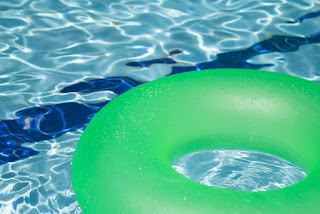Risks of Using Baby Neck Buoys
Seeing your little one swimming using a baby neck float certainly looks adorable, right, Bun. However, this swimming equipment has side effects that must be watched out for, you know. Come on, find out the facts about using a baby neck float in the following article. Swimming is a type of exercise that is good for anyone, including babies. Babies can start to be invited to play in water in shallow swimming pools when they reach 6 months of age. To increase safety while swimming, baby neck floats are often used as a mainstay.
 |
| Risks of Using Baby Neck Buoys |
Risks of Using Baby Neck Buoys
Baby neck floats are commonly used during water therapy as a treatment at baby spas. This swimming kit is shaped like a ring that is wrapped around the baby's neck. The existence of a neck float keeps the baby's head above the water, so that he can breathe even though he is placed in a fairly deep pool.
But, unfortunately, behind the adorable and funny behavior of a baby who is engrossed in swimming using this neck float, there are bad effects that lurk on his health, you know, Bun.
The use of a baby neck float can make the muscles in the neck stiff and tense. If this float is used frequently, it is feared that neck muscle injuries may occur which will adversely affect the growth of the baby's spine.
Even though it is claimed to increase safety so that the baby does not drown, using a neck float can also narrow the baby's space for movement. Your baby will have trouble turning his head, making expressions, or touching his head with his hands. This can make the baby feel uncomfortable because it is difficult to do something.
Not only that, the use of a neck float that is too tight can make it difficult for the baby to breathe. The risk of a baby drowning can also increase if used incorrectly or if the float is accidentally deflated.
Safe Tips for Swimming with Babies
Using a baby neck float is not recommended, but that doesn't mean you can't take your little one swimming. You see, swimming is very beneficial for building muscles, training body balance and coordination, improving brain function, and increasing your little one's self-confidence.
If Mother wants to take her little one to swim, go into the pool with her. The interaction and touch between Mother and Little One while in the pool will make them feel safe and comfortable, so that it can also increase the closeness between Mother and Little One.
In addition, there are some tips that you need to do, namely:
- Get your little one used to soaking in a baby tub or small rubber pool at home before taking him to swim in the pool.
- Make sure the swimming pool temperature is warm enough, which is around 32 degrees Celsius.
- Always hold your little one tightly and keep him close to your body.
- Give your little one praise and show him a happy expression so he can feel happy and safe playing in the water.
- Start swimming with your little one for 10-20 minutes, then increase the length of play gradually in the following sessions.
Currently, the use of a baby neck float has been banned by the United States Food and Drug Administration (FDA). This is because a baby neck float can actually harm the baby and no benefit is found.
If you want to take your little one swimming, you shouldn't need to use a baby neck float, okay? So that your little one can swim safely and comfortably, always hold your little one while in the water. Also apply the tips for swimming with babies as described above.
Don't forget to pay attention to your little one's reaction and condition after swimming. If your little one looks itchy or has skin irritation, take him to the doctor so he can be given the right treatment.
Related Searches:
- buoys,
- noaa buoys,
- lake michigan buoys,
- navigation buoys,
- boat buoys,
- big buoys kimberling city,
- buoys for sale,
- mooring buoys,
- types of buoys,
- can buoys,

Post a Comment for "Risks of Using Baby Neck Buoys"